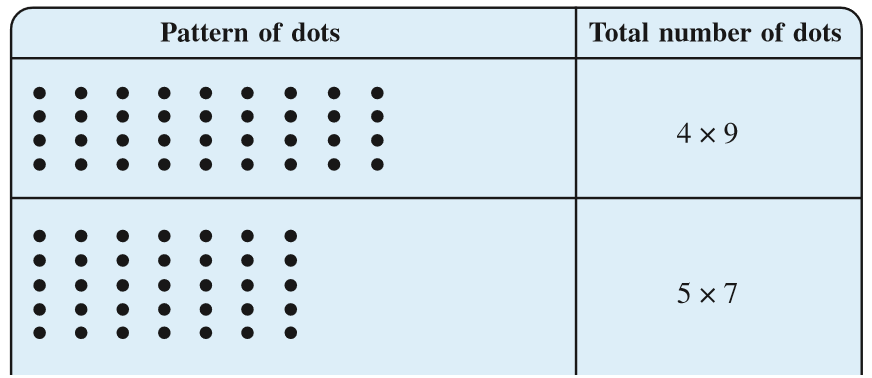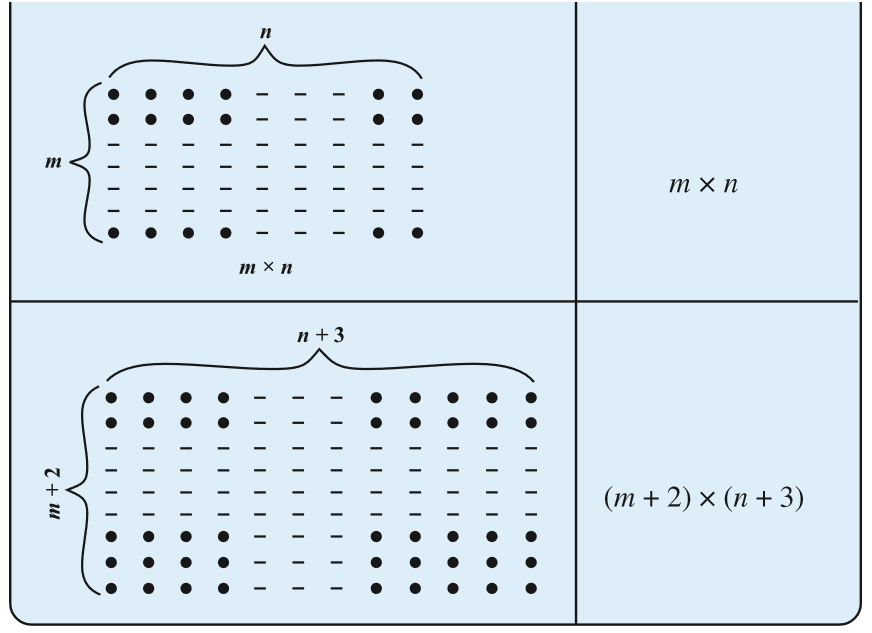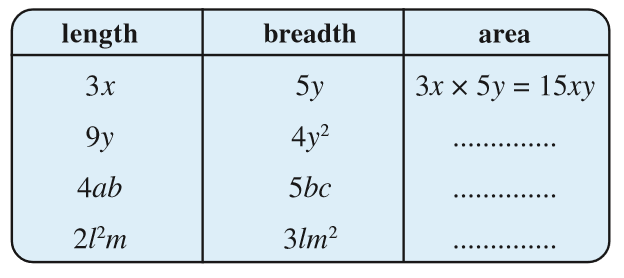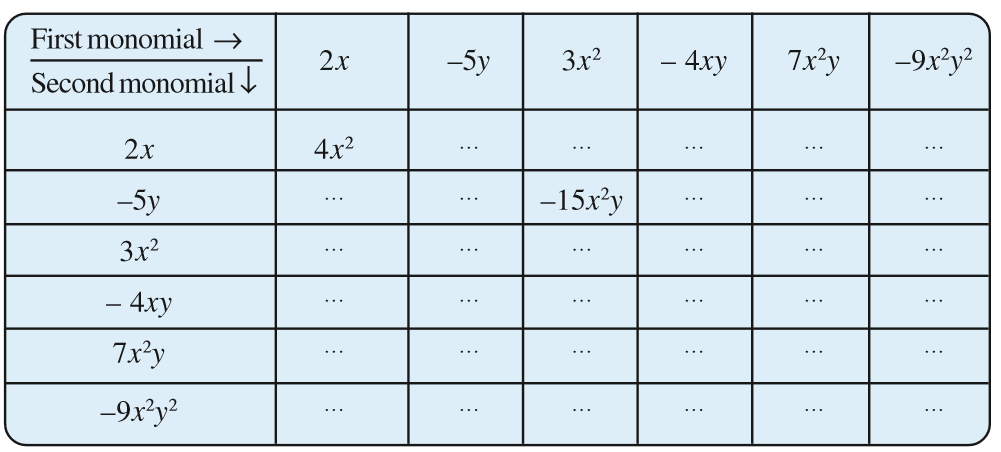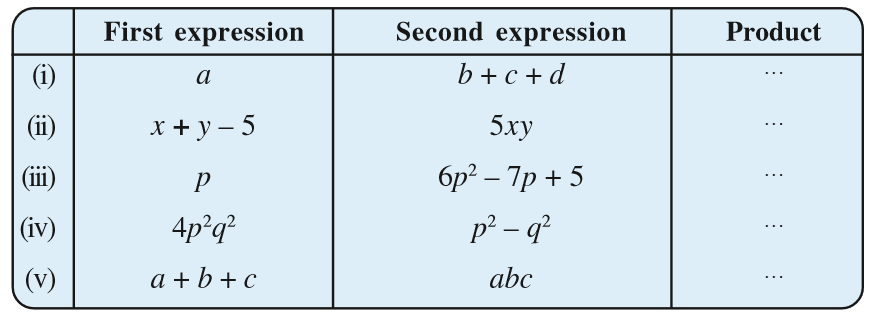Table of Contents
9.1 What are Expressions?
In earlier classes, we have already become familiar with what algebraic expressions (or simply expressions) are. Examples of expressions are:
x + 3, 2y – 5, 3x2, 4xy + 7 etc.
You can form many more expressions. As you know expressions are formed from variables and constants. The expression 2y – 5 is formed from the variable y and constants 2 and 5. The expression 4xy + 7 is formed from variables x and y and constants 4 and 7.
We know that, the value of y in the expression, 2y – 5, may be anything. It can be
2, 5, –3, 0,  etc.; actually countless different values. The value of an expression changes with the value chosen for the variables it contains. Thus as y takes on different values, the value of 2y – 5 goes on changing. When y = 2, 2y – 5 = 2(2) – 5 = –1; when y = 0, 2y – 5 = 2 × 0 –5 = –5, etc. Find the value of the expression 2y – 5 for the other given values of y.
etc.; actually countless different values. The value of an expression changes with the value chosen for the variables it contains. Thus as y takes on different values, the value of 2y – 5 goes on changing. When y = 2, 2y – 5 = 2(2) – 5 = –1; when y = 0, 2y – 5 = 2 × 0 –5 = –5, etc. Find the value of the expression 2y – 5 for the other given values of y.
Number line and an expression:
Consider the expression x + 5. Let us say the variable x has a position X on the number line;

X may be anywhere on the number line, but it is definite that the value of x + 5 is given by a point P, 5 units to the right of X. Similarly, the value of x – 4 will be 4 units to the left of X and so on.
What about the position of 4x and 4x + 5?


The position of 4x will be point C; the distance of C from the origin will be four times the distance of X from the origin. The position D of 4x + 5 will be 5 units to the right of C.

TRY THESE
1. Give five examples of expressions containing one variable and five examples of expressions containing two variables.
9.2 Terms, Factors and Coefficients
Take the expression 4x + 5. This expression is made up of two terms, 4x and 5. Terms are added to form expressions. Terms themselves can be formed as the product of factors. The term 4x is the product of its factors 4 and x. The term 5 is made up of just one factor, i.e., 5.
TRY THESE
Identify the coefficient of each term in the expression
x2y2 – 10x2y + 5xy2 – 20.
The expression 7xy – 5x has two terms 7xy and –5x. The term 7xy is a product of factors 7, x and y. The numerical factor of a term is called its numerical coefficient or simply coefficient. The coefficient in the term 7xy is 7 and the coefficient in the term –5x is –5.
9.3 Monomials, Binomials and Polynomials
Expression that contains only one term is called a monomial. Expression that contains two terms is called a binomial. An expression containing three terms is a trinomial and so on. In general, an expression containing, one or more terms with non-zero coefficient (with variables having non negative integers as exponents) is called a polynomial. A polynomial may contain any number of terms, one or more than one.
Examples of monomials: 4x2, 3xy, –7z, 5xy2, 10y, –9, 82mnp, etc.
Examples of binomials: a + b, 4l + 5m, a + 4, 5 –3xy, z2 – 4y2, etc.
Examples of trinomials: a + b + c, 2x + 3y – 5, x2y – xy2 + y2, etc.
Examples of polynomials: a + b + c + d, 3xy, 7xyz – 10, 2x + 3y + 7z, etc.

TRY THESE
1. Classify the following polynomials as monomials, binomials, trinomials.
– z + 5, x + y + z, y + z + 100, ab – ac, 17
2. Construct
9.4 Like and Unlike Terms
Look at the following expressions:
7x, 14x, –13x, 5x2, 7y, 7xy, –9y2, –9x2, –5yx
Like terms from these are:
(i) 7x, 14x, –13x are like terms.
(ii) 5x2 and –9x2 are like terms.
(iii) 7xy and –5yx are like terms.
Why are 7x and 7y not like?
Why are 7x and 7xy not like?
Why are 7x and 5x2 not like?

TRY THESE
Write two terms which are like
(i) 7xy (ii) 4mn2 (iii) 2l
9.5 Addition and Subtraction of Algebraic Expressions
In the earlier classes, we have also learnt how to add and subtract algebraic expressions. For example, to add 7x2 – 4x + 5 and 9x – 10, we do
7x2 – 4x + 5
+ 9x – 10
7x2 + 5x – 5
Observe how we do the addition. We write each expression to be added in a separate row. While doing so we write like terms one below the other, and add them, as shown. Thus 5 + (–10) = 5 –10 = –5. Similarly, – 4x + 9x = (– 4 + 9)x = 5x. Let us take some more examples.
Example 1: Add: 7xy + 5yz – 3zx, 4yz + 9zx – 4y , –3xz + 5x – 2xy.
Solution: Writing the three expressions in separate rows, with like terms one below the other, we have
7xy + 5yz – 3zx
+ 4yz + 9zx – 4y
+ –2xy – 3zx + 5x (Note xz is same as zx)
5xy + 9yz + 3zx + 5x – 4y
Thus, the sum of the expressions is 5xy + 9yz + 3zx + 5x – 4y. Note how the terms, – 4y in the second expression and 5x in the third expression, are carried over as they are, since they have no like terms in the other expressions.
Example 2: Subtract 5x2 – 4y2 + 6y – 3 from 7x2 – 4xy + 8y2 + 5x – 3y.
Solution:
7x2 – 4xy + 8y2 + 5x – 3y
5x2 – 4y2 + 6y – 3
(–) (+) (–) (+)
2x2 – 4xy + 12y2 + 5x – 9y + 3
Note that subtraction of a number is the same as addition of its additive inverse. Thus subtracting –3 is the same as adding +3. Similarly, subtracting 6y is the same as adding – 6y; subtracting – 4y2 is the same as adding 4y2 and so on. The signs in the third row written below each term in the second row help us in knowing which operation has to be performed.

Exercise 9.1
1. Identify the terms, their coefficients for each of the following expressions.
(i) 5xyz2 – 3zy (ii) 1 + x + x2 (iii) 4x2y2 – 4x2y2z2 + z2
(iv) 3 – pq + qr – rp (v)  (vi) 0.3a – 0.6ab + 0.5b
(vi) 0.3a – 0.6ab + 0.5b
2. Classify the following polynomials as monomials, binomials, trinomials. Which polynomials do not fit in any of these three categories?
x + y, 1000, x + x2 + x3 + x4, 7 + y + 5x, 2y – 3y2, 2y – 3y2 + 4y3, 5x – 4y + 3xy, 4z – 15z2, ab + bc + cd + da, pqr, p2q + pq2, 2p + 2q
3. Add the following.
(i) ab – bc, bc – ca, ca – ab (ii) a – b + ab, b – c + bc, c – a + ac
(iii) 2p2q2 – 3pq + 4, 5 + 7pq – 3p2q2 (iv) l2 + m2, m2 + n2, n2 + l2,2lm + 2mn + 2nl
4. (a) Subtract 4a – 7ab + 3b + 12 from 12a – 9ab + 5b – 3
(b) Subtract 3xy + 5yz – 7zx from 5xy – 2yz – 2zx + 10xyz
(c) Subtract 4p2q – 3pq + 5pq2 – 8p + 7q – 10 from
18 – 3p – 11q + 5pq – 2pq2 + 5p2q
9.6 Multiplication of Algebraic Expressions: Introduction
(i) Look at the following patterns of dots.
(ii) Can you now think of similar other situations in which two algebraic expressions have to be multiplied?
Ameena gets up. She says, “We can think of area of a rectangle.” The area of a rectangle is l × b, where l is the length, and b is breadth. If the length of the rectangle is increased by 5 units, i.e., (l + 5) and breadth is decreased by 3 units , i.e., (b – 3) units, the area of the new rectangle will be (l + 5) × (b – 3).
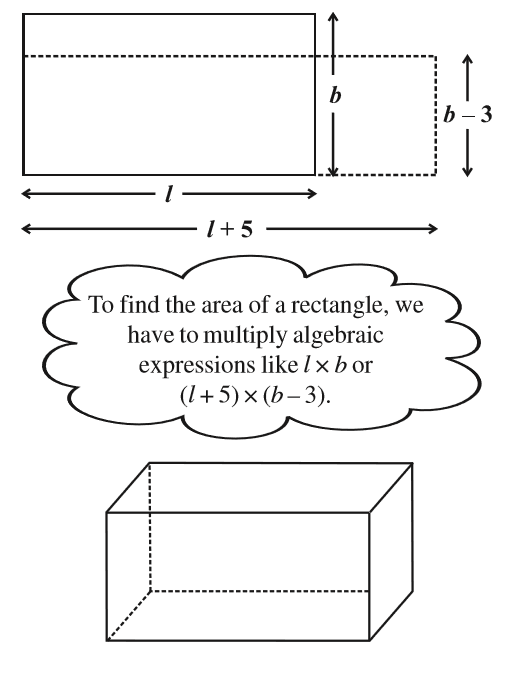
(iii) Can you think about volume? (The volume of a rectangular box is given by the product of its length, breadth and height).
(iv) Sarita points out that when we buy things, we have to carry out multiplication. For example, if
price of bananas per dozen = ` p
and for the school picnic bananas needed = z dozens,
then we have to pay = ` p × z
Suppose, the price per dozen was less by ` 2 and the bananas needed were less by 4 dozens.
Then, price of bananas per dozen = ` (p – 2)
and bananas needed = (z – 4) dozens,
Therefore, we would have to pay = ` (p – 2) × (z – 4)

TRY THESE
Can you think of two more such situations, where we may need to multiply algebraic expressions?
[Hint: • Think of speed and time;
• Think of interest to be paid, the principal and the rate of simple interest; etc.]
9.7 Multiplying a Monomial by a Monomial
9.7.1 Multiplying two monomials
In all the above examples, we had to carry out multiplication of two or more quantities. If the quantities are given by algebraic expressions, we need to find their product. This means that we should know how to obtain this product. Let us do this systematically. To begin with we shall look at the multiplication of two monomials.
We begin with
Similarly, 4 × (3x) = 3x + 3x + 3x + 3x = 12x
Now, observe the following products.
(i) x × 3y = x × 3 × y = 3 × x × y = 3xy
(ii) 5x × 3y = 5 × x × 3 × y = 5 × 3 × x × y = 15xy
(iii) 5x × (–3y) = 5 × x × (–3) × y
= 5 × (–3) × x × y = –15xy
Some more useful examples follow.
(iv) 5x × 4x2 = (5 × 4) × (x × x2)
= 20 × x3 = 20x3
i.e., coefficient of product = coefficient of first monomial × coefficient of second monomial;
and x × x2 = x3
i.e., algebraic factor of product
= algebraic factor of first monomial
× algebraic factor of second monomial.
(v) 5x × (– 4xyz) = (5 × – 4) × (x × xyz)
= –20 × (x × x × yz) = –20x2yz
Observe how we collect the powers of different variables in the algebraic parts of the two monomials. While doing so, we use the rules of exponents and powers.
9.7.2 Multiplying three or more monomials
Observe the following examples.
(i) 2x × 5y × 7z = (2x × 5y) × 7z = 10xy × 7z = 70xyz
(ii) 4xy × 5x2y2 × 6x3y3 = (4xy × 5x2y2) × 6x3y3 = 20x3y3 × 6x3y3 = 120x3y3 × x3y3
= 120 (x3 × x3) × (y3 × y3) = 120x6 × y6 = 120x6y6
It is clear that we first multiply the first two monomials and then multiply the resulting monomial by the third monomial. This method can be extended to the product of any number of monomials.
We can find the product in other way also.
4xy × 5x2y2 × 6x3 y3
= (4 × 5 × 6) × (x × x2 × x3) × (y × y2 × y3)
= 120 x6y6

TRY THESE
Find 4x × 5y × 7z
First find 4x × 5y and multiply it by 7z;
or first find 5y × 7z and multiply it by 4x.
Is the result the same? What do you observe?
Does the order in which you carry out the multiplication matter?
Example 3: Complete the table for area of a rectangle with given length and breadth.
Solution:
Example 4: Find the volume of each rectangular box with given length, breadth and height.
Solution: Volume = length × breadth × height
Hence, for (i) volume = (2ax) × (3by) × (5cz)
= 2 × 3 × 5 × (ax) × (by) × (cz) = 30abcxyz
for (ii) volume = m2n × n2p × p2m
= (m2 × m) × (n × n2) × (p × p2) = m3n3p3
for (iii) volume = 2q × 4q2 × 8q3
= 2 × 4 × 8 × q × q2 × q3 = 64q6
Exercise 9.2
1. Find the product of the following pairs of monomials.
(i) 4, 7p (ii) – 4p, 7p (iii) – 4p, 7pq (iv) 4p3, – 3p
(v) 4p, 0
2. Find the areas of rectangles with the following pairs of monomials as their lengths and breadths respectively.
(p, q); (10m, 5n); (20x2, 5y2); (4x, 3x2); (3mn, 4np)
3. Complete the table of products.
4. Obtain the volume of rectangular boxes with the following length, breadth and height respectively.
(i) 5a, 3a2, 7a4 (ii) 2p, 4q, 8r (iii) xy, 2x2y, 2xy2 (iv) a, 2b, 3c
5. Obtain the product of
(i) xy, yz, zx (ii) a, – a2, a3 (iii) 2, 4y, 8y2, 16y3
(iv) a, 2b, 3c, 6abc (v) m, – mn, mnp
9.8 Multiplying a Monomial by a Polynomial
9.8.1 Multiplying a monomial by a binomial
Let us multiply the monomial 3x by the binomial 5y + 2, i.e., find 3x × (5y + 2) = ?
Recall that 3x and (5y + 2) represent numbers. Therefore, using the distributive law,
3x × (5y + 2) = (3x × 5y) + (3x × 2) = 15xy + 6x
7 × 106 = 7 × (100 + 6)
= 7 × 100 + 7 × 6 (Here, we used distributive law)
= 700 + 42 = 742
7 × 38 = 7 × (40 – 2)
= 7 × 40 – 7 × 2 (Here, we used distributive law)
= 280 – 14 = 266
Similarly, (–3x) × (–5y + 2) = (–3x) × (–5y) + (–3x) × (2) = 15xy – 6x
and 5xy × (y2 + 3) = (5xy × y2) + (5xy × 3) = 5xy3 + 15xy.
What about a binomial × monomial? For example, (5y + 2) × 3x = ?
We may use commutative law as : 7 × 3 = 3 × 7; or in general a × b = b × a
Similarly, (5y + 2) × 3x = 3x × (5y + 2) = 15xy + 6x as before.
TRY THESE
Find the product (i) 2x (3x + 5xy) (ii) a2 (2ab – 5c)
9.8.2 Multiplying a monomial by a trinomial
Consider 3p × (4p2 + 5p + 7). As in the earlier case, we use distributive law;
3p × (4p2 + 5p + 7) = (3p × 4p2) + (3p × 5p) + (3p × 7)
= 12p3 + 15p2 + 21p
Multiply each term of the trinomial by the monomial and add products.
Observe, by using the distributive law, we are able to carry out the multiplication term by term.
TRY THESE
Find the product: (4p2 + 5p + 7) × 3p
Example 5: Simplify the expressions and evaluate them as directed:
(i) x (x – 3) + 2 for x = 1, (ii) 3y (2y – 7) – 3 (y – 4) – 63 for y = –2
Solution:
(i) x (x – 3) + 2 = x2 – 3x + 2
For x = 1, x2 – 3x + 2 = (1)2 – 3 (1) + 2
= 1 – 3 + 2 = 3 – 3 = 0
(ii) 3y (2y – 7) – 3 (y – 4) – 63 = 6y2 – 21y – 3y + 12 – 63
= 6y2 – 24y – 51
For y = –2, 6y2 – 24y – 51 = 6 (–2)2 – 24(–2) – 51
= 6 × 4 + 24 × 2 – 51
= 24 + 48 – 51 = 72 – 51 = 21
Example 6: Add
(i) 5m (3 – m) and 6m2 – 13m (ii) 4y (3y2 + 5y – 7) and 2 (y3 – 4y2 + 5)
Solution:
(i) First expression = 5m (3 – m) = (5m × 3) – (5m × m) = 15m – 5m2
Now adding the second expression to it,15m – 5m2 + 6m2 – 13m = m2 + 2m
(ii) The first expression = 4y (3y2 + 5y – 7) = (4y × 3y2) + (4y × 5y) + (4y × (–7))
= 12y3 + 20y2 – 28y
The second expression = 2 (y3 – 4y2 + 5) = 2y3 + 2 × (– 4y2) + 2 × 5
= 2y3 – 8y2 + 10
Adding the two expressions, 12y3 + 20y2 – 28y
+ 2y3 – 8y2 + 10
14y3 + 12y2 – 28y + 10
Example 7: Subtract 3pq (p – q) from 2pq (p + q).
Solution: We have 3pq (p – q) = 3p2q – 3pq2 and
Subtracting, 2p2q + 2pq2
3p2q – 3pq2
– +
– p2q + 5pq2

Exercise 9.3
1. Carry out the multiplication of the expressions in each of the following pairs.
(i) 4p, q + r (ii) ab, a – b (iii) a + b, 7a2b2 (iv) a2 – 9, 4a
(v) pq + qr + rp, 0
2. Complete the table.
First expression Second expression Product
3. Find the product.
Observe, every term in one binomial multiplies every term in the other binomial.
(i) (a2) × (2a22) × (4a26) (ii) 
(iii)  (iv) x × x2 × x3 × x4
(iv) x × x2 × x3 × x4
4. (a) Simplify 3x (4x – 5) + 3 and find its values for (i) x = 3 (ii) x =  .
.
(b) Simplify a (a2 + a + 1) + 5 and find its value for (i) a = 0, (ii) a = 1
(iii) a = – 1.
5. (a) Add: p ( p – q), q ( q – r) and r ( r – p)
(b) Add: 2x (z – x – y) and 2y (z – y – x)
(c) Subtract: 3l (l – 4 m + 5 n) from 4l ( 10 n – 3 m + 2 l )
(d) Subtract: 3a (a + b + c ) – 2 b (a – b + c) from 4c ( – a + b + c )
9.9 Multiplying a Polynomial by a Polynomial
9.9.1 Multiplying a binomial by a binomial
Let us multiply one binomial (2a + 3b) by another binomial, say (3a + 4b). We do this step-by-step, as we did in earlier cases, following the distributive law of multiplication,
(3a + 4b) × (2a + 3b) = 3a × (2a + 3b) + 4b × (2a + 3b)
Observe, every term in one binomial multiplies every term in the other binomial
= (3a × 2a) + (3a × 3b) + (4b × 2a) + (4b × 3b)
= 6a2 + 9ab + 8ba + 12b2
= 6a2 + 17ab + 12b2 (Since ba = ab)
When we carry out term by term multiplication, we expect 2 × 2 = 4 terms to be present. But two of these are like terms, which are combined, and hence we get 3 terms. In multiplication of polynomials with polynomials, we should always look for like terms, if any, and combine them.
Example 8: Multiply
(i) (x – 4) and (2x + 3) (ii) (x – y) and (3x + 5y)
Solution:
(i) (x – 4) × (2x + 3) = x × (2x + 3) – 4 × (2x + 3)
= (x × 2x) + (x × 3) – (4 × 2x) – (4 × 3) = 2x2 + 3x – 8x – 12
= 2x2 – 5x – 12 (Adding like terms)
(ii) (x – y) × (3x + 5y) = x × (3x + 5y) – y × (3x + 5y)
= (x × 3x) + (x × 5y) – (y × 3x) – ( y × 5y)
= 3x2 + 5xy – 3yx – 5y2 = 3x2 + 2xy – 5y2 (Adding like terms)
Example 9: Multiply
(i) (a + 7) and (b – 5) (ii) (a2 + 2b2) and (5a – 3b)
Solution:
(i) (a + 7) × (b – 5) = a × (b – 5) + 7 × (b – 5)
= ab – 5a + 7b – 35
[using the distributive law]
Note that there are no like terms involved in this multiplication.
(ii) (a2 + 2b2) × (5a – 3b) = a2 (5a – 3b) + 2b2 × (5a – 3b)
= 5a3 – 3a2b + 10ab2 – 6b3
9.9.2 Multiplying a binomial by a trinomial
In this multiplication, we shall have to multiply each of the three terms in the trinomial by each of the two terms in the binomial. We shall get in all 3 × 2 = 6 terms, which may reduce to 5 or less, if the term by term multiplication results in like terms. Consider
 ×
×  = a × (a2 + 3a + 5) + 7 × (a2 + 3a + 5)
= a × (a2 + 3a + 5) + 7 × (a2 + 3a + 5)
= a3 + 3a2 + 5a + 7a2 + 21a + 35
= a3 + (3a2 + 7a2) + (5a + 21a) + 35
= a3 + 10a2 + 26a + 35 (Why are there only 4 terms in the final result?)
Example 10: Simplify (a + b) (2a – 3b + c) – (2a – 3b) c.
Solution: We have
= 2a2 – 3ab + ac + 2ab – 3b2 + bc
= 2a2 – ab – 3b2 + bc + ac (Note, –3ab and 2ab
are like terms)
and (2a – 3b) c = 2ac – 3bc
Therefore,
(a + b) (2a – 3b + c) – (2a – 3b) c = 2a2 – ab – 3b2 + bc + ac – (2ac – 3bc)
= 2a2 – ab – 3b2 + bc + ac – 2ac + 3bc
= 2a2 – ab – 3b2 + (bc + 3bc) + (ac – 2ac)
= 2a2 – 3b2 – ab + 4bc – ac

Exercise 9.4
1. Multiply the binomials.
(i) (2x + 5) and (4x – 3) (ii) (y – 8) and (3y – 4)
(iii) (2.5l – 0.5m) and (2.5l + 0.5m) (iv) (a + 3b) and (x + 5)
(v) (2pq + 3q2) and (3pq – 2q2)
(vi) 
2. Find the product.
(i) (5 – 2x) (3 + x) (ii) (x + 7y) (7x – y)
(iii) (a2 + b) (a + b2) (iv) (p2 – q2) (2p + q)
3. Simplify.
(i) (x2 – 5) (x + 5) + 25 (ii) (a2 + 5) (b3 + 3) + 5
(iii) (t + s2) (t2 – s)
(iv) (a + b) (c – d) + (a – b) (c + d) + 2 (ac + bd)
(v) (x + y)(2x + y) + (x + 2y)(x – y) (vi) (x + y)(x2 – xy + y2)
(vii) (1.5x – 4y)(1.5x + 4y + 3) – 4.5x + 12y
(viii) (a + b + c)(a + b – c)
9.10 What is an Identity?
Consider the equality (a + 1) (a +2) = a2 + 3a + 2
We shall evaluate both sides of this equality for some value of a, say a = 10.
For a = 10, LHS = (a + 1) (a + 2) = (10 + 1) (10 + 2) = 11 × 12 = 132
RHS = a2 + 3a + 2 = 102 + 3 × 10 + 2 = 100 + 30 + 2 = 132
Thus, the values of the two sides of the equality are equal for a = 10.
Let us now take a = –5
LHS = (a + 1) (a + 2) = (–5 + 1) (–5 + 2) = (– 4) × (–3) = 12
RHS = a2 + 3a + 2 = (–5)2 + 3 (–5) + 2
= 25 – 15 + 2 = 10 + 2 = 12
Thus, for a = –5, also LHS = RHS.
We shall find that for any value of a, LHS = RHS. Such an equality, true for every value of the variable in it, is called an identity. Thus,
(a + 1) (a + 2) = a2 + 3a + 2 is an identity.
An equation is true for only certain values of the variable in it. It is not true for all values of the variable. For example, consider the equation
a2 + 3a + 2 = 132
It is true for a = 10, as seen above, but it is not true for a = –5 or for a = 0 etc.
Try it: Show that a2 + 3a + 2 = 132 is not true for a = –5 and for a = 0.
9.11 Standard Identities
We shall now study three identities which are very useful in our work. These identities are obtained by multiplying a binomial by another binomial.
Let us first consider the product (a + b) (a + b) or (a + b)2.
(a + b)2 = (a + b) (a + b)
= a(a + b) + b (a + b)
= a2 + ab + ba + b2
= a2 + 2ab + b2 (since ab = ba)
Thus (a + b)2 = a2 + 2ab + b2 (I)
Clearly, this is an identity, since the expression on the RHS is obtained from the LHS by actual multiplication. One may verify that for any value of a and any value of b, the values of the two sides are equal.
• Next we consider (a – b)2 = (a – b) (a – b) = a (a – b) – b (a – b)
We have = a2 – ab – ba + b2 = a2 – 2ab + b2
or (a – b)2 = a2 – 2ab + b2 (II)
• Finally, consider (a + b) (a – b). We have (a + b) (a – b) = a (a – b) + b (a – b)
= a2 – ab + ba – b2 = a2 – b2 (since ab = ba)
or (a + b) (a – b) = a2 – b2 (III)
The identities (I), (II) and (III) are known as standard identities.

TRY THESE
1. Put – b in place of b in Identity (I). Do you get Identity (II)?
• We shall now work out one more useful identity.
(x + a) (x + b) = x (x + b) + a (x + b)
= x2 + bx + ax + ab
or (x + a) (x + b) = x2 + (a + b) x + ab (IV)

TRY THESE
1. Verify Identity (IV), for a = 2, b = 3, x = 5.
2. Consider, the special case of Identity (IV) with a = b, what do you get? Is it related to Identity (I)?
3. Consider, the special case of Identity (IV) with a = – c and b = – c. What do you get? Is it related to Identity (II)?
4. Consider the special case of Identity (IV) with b = – a. What do you get? Is it related to Identity (III)?
We can see that Identity (IV) is the general form of the other three identities also.
9.12 Applying Identities
We shall now see how, for many problems on multiplication of binomial expressions and also of numbers, use of the identities gives a simple alternative method of solving them.
Example 11: Using the Identity (I), find (i) (2x + 3y)2 (ii) 1032
Solution:
(i) (2x + 3y)2 = (2x)2 + 2(2x) (3y) + (3y)2 [Using the Identity (I)]
= 4x2 + 12xy + 9y2
We may work out (2x + 3y)2 directly.
(2x + 3y)2 = (2x + 3y) (2x + 3y)
= (2x) (2x) + (2x) (3y) + (3y) (2x) + (3y) (3y)
= 4x2 + 6xy + 6 yx + 9y2 (as xy = yx)
= 4x2 + 12xy + 9y2
Using Identity (I) gave us an alternative method of squaring (2x + 3y). Do you notice that the Identity method required fewer steps than the above direct method? You will realise the simplicity of this method even more if you try to square more complicated binomial expressions than (2x + 3y).
(ii) (103)2 = (100 + 3)2
= 1002 + 2 × 100 × 3 + 32 (Using Identity I)
= 10000 + 600 + 9 = 10609
We may also directly multiply 103 by 103 and get the answer. Do you see that Identity (I) has given us a less tedious method than the direct method of squaring 103? Try squaring 1013. You will find in this case, the method of using identities even more attractive than the direct multiplication method.
Example 12: Using Identity (II), find (i) (4p – 3q)2 (ii) (4.9)2
Solution:
(i) (4p – 3q)2 = (4p)2 – 2 (4p) (3q) + (3q)2 [Using the Identity (II)]
= 16p2 – 24pq + 9q2
(ii) (4.9)2 = (5.0 – 0.1)2 = (5.0)2 – 2 (5.0) (0.1) + (0.1)2
= 25.00 – 1.00 + 0.01 = 24.01
Is it not that, squaring 4.9 using Identity (II) is much less tedious than squaring it by direct multiplication?
Example 13: Using Identity (III), find
(i)  (ii) 9832 – 172 (iii) 194 × 206
(ii) 9832 – 172 (iii) 194 × 206
Solution:
(i)  =
= 
= 
Try doing this directly. You will realise how easy our method of using Identity (III) is.
[Here a = 983, b = 17, a2 – b2 = (a + b) (a – b)]
(iii) 194 × 206 = (200 – 6) × (200 + 6) = 2002 – 62
= 40000 – 36 = 39964
Example 14: Use the Identity (x + a) (x + b) = x2 + (a + b) x + ab to find the following:
(i) 501 × 502 (ii) 95 × 103
Solution:
(i) 501 × 502 = (500 + 1) × (500 + 2) = 5002 + (1 + 2) × 500 + 1 × 2
= 250000 + 1500 + 2 = 251502
(ii) 95 × 103 = (100 – 5) × (100 + 3) = 1002 + (–5 + 3) × 100 + (–5) × 3
= 10000 – 200 – 15 = 9785

Exercise 9.5
1. Use a suitable identity to get each of the following products.
(i) (x + 3) (x + 3) (ii) (2y + 5) (2y + 5) (iii) (2a – 7) (2a – 7)
(iv) (3a –  ) (3a –
) (3a –  ) (v) (1.1m – 0.4) (1.1m + 0.4)
) (v) (1.1m – 0.4) (1.1m + 0.4)
(vi) (a2 + b2) (– a2 + b2) (vii) (6x – 7) (6x + 7) (viii) (– a + c) (– a + c)
(ix)  (x) (7a – 9b) (7a – 9b)
(x) (7a – 9b) (7a – 9b)
2. Use the identity (x + a) (x + b) = x2 + (a + b) x + ab to find the following products.
(i) (x + 3) (x + 7) (ii) (4x + 5) (4x + 1)
(iii) (4x – 5) (4x – 1) (iv) (4x + 5) (4x – 1)
(v) (2x + 5y) (2x + 3y) (vi) (2a2 + 9) (2a2 + 5)
(vii) (xyz – 4) (xyz – 2)
3. Find the following squares by using the identities.
(i) (b – 7)2 (ii) (xy + 3z)2 (iii) (6x2 – 5y)2
(iv)  (v) (0.4p – 0.5q)2 (vi) (2xy + 5y)2
(v) (0.4p – 0.5q)2 (vi) (2xy + 5y)2
4. Simplify.
(i) (a2 – b2)2 (ii) (2x + 5)2 – (2x – 5)2
(iii) (7m – 8n)2 + (7m + 8n)2 (iv) (4m + 5n)2 + (5m + 4n)2
(v) (2.5p – 1.5q)2 – (1.5p – 2.5q)2
(vi) (ab + bc)2 – 2ab2c (vii) (m2 – n2m)2 + 2m3n2
5. Show that.
(i) (3x + 7)2 – 84x = (3x – 7)2 (ii) (9p – 5q)2 + 180pq = (9p + 5q)2
(iii)  + 2mn =
+ 2mn = 
(iv) (4pq + 3q)2 – (4pq – 3q)2 = 48pq2
(v) (a – b) (a + b) + (b – c) (b + c) + (c – a) (c + a) = 0
6. Using identities, evaluate.
(i) 712 (ii) 992 (iii) 1022 (iv) 9982
(v) 5.22 (vi) 297 × 303 (vii) 78 × 82 (viii) 8.92
(ix) 10.5 × 9.5
7. Using a2 – b2 = (a + b) (a – b), find
(i) 512 – 492 (ii) (1.02)2 – (0.98)2 (iii) 1532 – 1472
(iv) 12.12 – 7.92
8. Using (x + a) (x + b) = x2 + (a + b) x + ab, find
(i) 103 × 104 (ii) 5.1 × 5.2 (iii) 103 × 98 (iv) 9.7 × 9.8
What have we Discussed?
1. Expressions are formed from variables and constants.
2. Terms are added to form expressions. Terms themselves are formed as product of factors.
3. Expressions that contain exactly one, two and three terms are called monomials, binomials and trinomials respectively. In general, any expression containing one or more terms with non-zero coefficients (and with variables having non- negative integers as exponents) is called a polynomial.
4. Like terms are formed from the same variables and the powers of these variables are the same, too. Coefficients of like terms need not be the same.
5. While adding (or subtracting) polynomials, first look for like terms and add (or subtract) them; then handle the unlike terms.
6. There are number of situations in which we need to multiply algebraic expressions: for example, in finding area of a rectangle, the sides of which are given as expressions.
7. A monomial multiplied by a monomial always gives a monomial.
8. While multiplying a polynomial by a monomial, we multiply every term in the polynomial by the monomial.
9. In carrying out the multiplication of a polynomial by a binomial (or trinomial), we multiply term by term, i.e., every term of the polynomial is multiplied by every term in the binomial (or trinomial). Note that in such multiplication, we may get terms in the product which are like and have to be combined.
10. An identity is an equality, which is true for all values of the variables in the equality.
On the other hand, an equation is true only for certain values of its variables. An equation is not an identity.
11. The following are the standard identities:
(a + b)2 = a2 + 2ab + b2 (I)
(a – b)2 = a2 – 2ab + b2 (II)
(a + b) (a – b) = a2 – b2 (III)
12. Another useful identity is (x + a) (x + b) = x2 + (a + b) x + ab (IV)
13. The above four identities are useful in carrying out squares and products of algebraic expressions. They also allow easy alternative methods to calculate products of numbers and so on.

